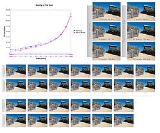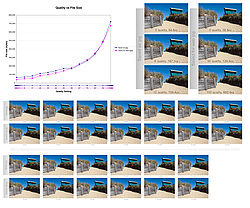
Image compression
Encyclopedia
The objective of image compression is to reduce irrelevance and redundancy of the image data in order to be able to store or transmit
data in an efficient form.

, or comics. This is because lossy compression methods, especially when used at low bit rate
s, introduce compression artifact
s. Lossy methods are especially suitable for natural images such as photographs in applications where minor (sometimes imperceptible) loss of fidelity is acceptable to achieve a substantial reduction in bit rate. The lossy compression that produces imperceptible differences may be called visually lossless.
Methods for lossless image compression are:
Methods for lossy compression:
Scalability generally refers to a quality reduction achieved by manipulation of the bitstream or file (without decompression and re-compression).
Other names for scalability are progressive coding or embedded bitstreams.
Despite its contrary nature, scalability also may be found in lossless codecs, usually in form of coarse-to-fine pixel scans.
Scalability is especially useful for previewing images while downloading them (e.g., in a web browser) or for providing variable quality access to e.g., databases.
There are several types of scalability:
Region of interest coding. Certain parts of the image are encoded with higher quality than others.
This may be combined with scalability (encode these parts first, others later).
Meta information. Compressed data may contain information about the image which may be used to categorize, search, or browse images.
Such information may include color and texture statistics, small preview
images, and author or copyright information.
Processing power. Compression algorithms require different amounts of processing power to encode and decode. Some high compression algorithms require high processing power.
The quality of a compression method often is measured by the Peak signal-to-noise ratio
. It measures the amount of noise introduced through a lossy compression of the image, however, the subjective judgment of the viewer also is regarded as an important measure, perhaps, being the most important measure.
Data transmission
Data transmission, digital transmission, or digital communications is the physical transfer of data over a point-to-point or point-to-multipoint communication channel. Examples of such channels are copper wires, optical fibres, wireless communication channels, and storage media...
data in an efficient form.

Lossy and lossless compression
Image compression may be lossy or lossless. Lossless compression is preferred for archival purposes and often for medical imaging, technical drawings, clip artClip art
Clip art, in the graphic arts, refers to pre-made images used to illustrate any medium. Today, clip art is used extensively in both personal and commercial projects, ranging from home-printed greeting cards to commercial candles. Clip art comes in many forms, both electronic and printed. However,...
, or comics. This is because lossy compression methods, especially when used at low bit rate
Bit rate
In telecommunications and computing, bit rate is the number of bits that are conveyed or processed per unit of time....
s, introduce compression artifact
Compression artifact
A compression artifact is a noticeable distortion of media caused by the application of lossy data compression....
s. Lossy methods are especially suitable for natural images such as photographs in applications where minor (sometimes imperceptible) loss of fidelity is acceptable to achieve a substantial reduction in bit rate. The lossy compression that produces imperceptible differences may be called visually lossless.
Methods for lossless image compression are:
- Run-length encodingRun-length encodingRun-length encoding is a very simple form of data compression in which runs of data are stored as a single data value and count, rather than as the original run...
– used as default method in PCXPCXPCX is an image file format developed by the now-defunct ZSoft Corporation of Marietta, Georgia. It was the native file format for PC Paintbrush and became one of the first widely accepted DOS imaging standards, although it has since been succeeded by more sophisticated image formats, such as GIF,...
and as one of possible in BMP, TGATGATGA may refer to:* The Grand Arkanum, A Nerdcore Hiphop Crew coming out of Worcester, Massachusetts consisting of Danny Fantom, The Prophet, Griffen, Kid Ikarus, and DJ Big Spoon* Thermogravimetric Analysis, materials testing procedure...
, TIFF - DPCMDPCMDifferential pulse-code modulation is a signal encoder that uses the baseline of pulse-code modulation but adds some functionalities based on the prediction of the samples of the signal...
and Predictive Coding - Entropy encodingEntropy encodingIn information theory an entropy encoding is a lossless data compression scheme that is independent of the specific characteristics of the medium....
- Adaptive dictionary algorithms such as LZWLZWLempel–Ziv–Welch is a universal lossless data compression algorithm created by Abraham Lempel, Jacob Ziv, and Terry Welch. It was published by Welch in 1984 as an improved implementation of the LZ78 algorithm published by Lempel and Ziv in 1978...
– used in GIF and TIFF - DeflationDEFLATEDeflate is a lossless data compression algorithm that uses a combination of the LZ77 algorithm and Huffman coding. It was originally defined by Phil Katz for version 2 of his PKZIP archiving tool and was later specified in RFC 1951....
– used in PNG, MNG, and TIFF - Chain codeChain codeA chain code is a lossless compression algorithm for monochrome images. The basic principle of chain codes is to separately encode each connected component, or "blot", in the image. For each such region, a point on the boundary is selected and its coordinates are transmitted...
s
Methods for lossy compression:
- Reducing the color space to the most common colors in the image. The selected colors are specified in the color palette in the header of the compressed image. Each pixel just references the index of a color in the color palette. This method can be combined with dithering to avoid posterizationPosterizationPosterization of an image entails conversion of a continuous gradation of tone to several regions of fewer tones, with abrupt changes from one tone to another. This was originally done with photographic processes to create posters...
. - Chroma subsamplingChroma subsamplingChroma subsampling is the practice of encoding images by implementing less resolution for chroma information than for luma information, taking advantage of the human visual system's lower acuity for color differences than for luminance....
. This takes advantage of the fact that the human eye perceives spatial changes of brightness more sharply than those of color, by averaging or dropping some of the chrominance information in the image. - Transform codingTransform codingTransform coding is a type of data compression for "natural" data like audio signals or photographic images. The transformation is typically lossy, resulting in a lower quality copy of the original input....
. This is the most commonly used method. A Fourier-related transform such as DCTDiscrete cosine transformA discrete cosine transform expresses a sequence of finitely many data points in terms of a sum of cosine functions oscillating at different frequencies. DCTs are important to numerous applications in science and engineering, from lossy compression of audio and images A discrete cosine transform...
or the wavelet transform are applied, followed by quantizationQuantization (image processing)Quantization, involved in image processing, is a lossy compression technique achieved by compressing a range of values to a single quantum value. When the number of discrete symbols in a given stream is reduced, the stream becomes more compressible. For example, reducing the number of colors...
and entropy coding. - Fractal compressionFractal compressionFractal compression is a lossy compression method for digital images, based on fractals. The method is best suited for textures and natural images, relying on the fact that parts of an image often resemble other parts of the same image...
.
Other properties
The best image quality at a given bit-rate (or compression rate) is the main goal of image compression, however, there are other important properties of image compression schemes:Scalability generally refers to a quality reduction achieved by manipulation of the bitstream or file (without decompression and re-compression).
Other names for scalability are progressive coding or embedded bitstreams.
Despite its contrary nature, scalability also may be found in lossless codecs, usually in form of coarse-to-fine pixel scans.
Scalability is especially useful for previewing images while downloading them (e.g., in a web browser) or for providing variable quality access to e.g., databases.
There are several types of scalability:
- Quality progressive or layer progressive: The bitstream successively refines the reconstructed image.
- Resolution progressive: First encode a lower image resolution; then encode the difference to higher resolutions.
- Component progressive: First encode grey; then color.
Region of interest coding. Certain parts of the image are encoded with higher quality than others.
This may be combined with scalability (encode these parts first, others later).
Meta information. Compressed data may contain information about the image which may be used to categorize, search, or browse images.
Such information may include color and texture statistics, small preview
PREview
PREview is a requirements method which focuses on the early stage of Requirements Engineering: discovering and documenting requirements. PREview uses a Viewpoint-Oriented Approach to enable the conversion of top-level goals into requirements and constraints...
images, and author or copyright information.
Processing power. Compression algorithms require different amounts of processing power to encode and decode. Some high compression algorithms require high processing power.
The quality of a compression method often is measured by the Peak signal-to-noise ratio
Peak signal-to-noise ratio
The phrase peak signal-to-noise ratio, often abbreviated PSNR, is an engineering term for the ratio between the maximum possible power of a signal and the power of corrupting noise that affects the fidelity of its representation...
. It measures the amount of noise introduced through a lossy compression of the image, however, the subjective judgment of the viewer also is regarded as an important measure, perhaps, being the most important measure.
External links
- MIT Linear Algebra Lecture on Image Compression at Google Video, from MIT OpenCourseWare(not available right now)
- Image Coding Fundamentals
- A study about image compression (Image compression basics and comparing different compression methods like JPEG2000, JPEG and JPEG XR / HD Photo)
- Data Compression Basics (includes comparison of PNG, JPEG and JPEG-2000 formats)
- FAQ:What is the state of the art in lossless image compression? from [news://comp.compression comp.compression]
- IPRG Open group related to image processing research resources

